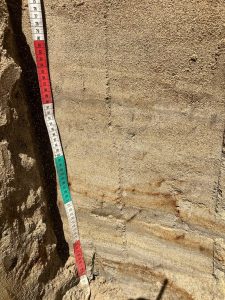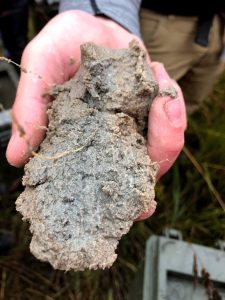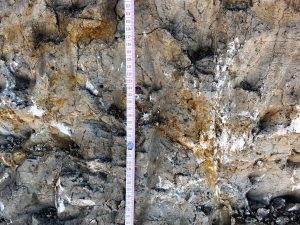Soil Redox Processes
Rivka Fidel
- Identify features of reduction-oxidation processes in soil
- Explain significance of redox features
Importance:

Reduction and oxidation (redox) reactions affect numerous soil processes, ultimately influencing nutrient availability and mobility, microbial activity, soil pH, and even soil color.
Redox processes alter soil’s appearance in ways that help us interpret soil formation conditions. Reduction and oxidation features (redox features, or redoximorphic features) are indicators of important soil conditions, particularly oxygen status. Even in drought conditions, soil redox features can be used to avoid potentially costly issues, like basement or septic system placement in an area with regularly saturated conditions.
Redox Reaction Basics
Reduction reactions occur when an element gains electrons from another element, reducing their charge (making the charge more negative). Oxidation reactions occur when an element loses electrons. To help you remember, you can use the mnemonic “LEO the lion says GER“, standing for:
- LEO: Loss of Electrons is Oxidation
- GER: Gain of Electrons is Reduction
Note that you would not expect to find many of the chemicals in these videos, like F2 or Mg0, in soil.
Some of the most common elements to undergo redox reactions in soil are iron (Fe) and manganese (Mn). They tend to lose their electrons to elements like O in oxygen gas (O2) and N in nitrate (NO3–).
Both O and N – nonmetal elements that frequently gain electrons, and become “reduced” – are what’s called oxidizing agents, because they help oxidize other elements. Of these, oxygen is the best oxidizing agent found in nature. That is why organisms that use oxygen for respiration are so common.
Metals like Fe and Mn, however, tend to act as reducing agents, because they help reduce the O and N.
You may have wondered why metals rust, or why you can’t find tiny bits of iron or copper ore lying around in the soil. “Rusting” phenomena are redox reactions! For example, the iron found in iron ore and cast iron pots is Fe0. Fe0 readily donates electrons, as shown in this half reaction:
Reduction Features:

Reduced conditions, shown by the grey colors, indicate a lack of oxygen in that soil area. This is frequently associated with saturated conditions, but additional factors can contribute. Even during a drought, redox colors developed due to regular saturation will still be present, making soil color an important indicator of expected wetness conditions.
A variety of different compounds in soil can be reduced (nitrate, iron, manganese, sulfur), maybe table of reducing energy here?
Reduced iron is mobile, meaning it can move in the soil solution until it comes in contact with oxygen.
Oxidation Features:

Reduction-oxidation features in soil are important indicators
- Gleyed conditions indicate frequent saturation
- Redox depletions and concentrations indicate a fluctuating water table

